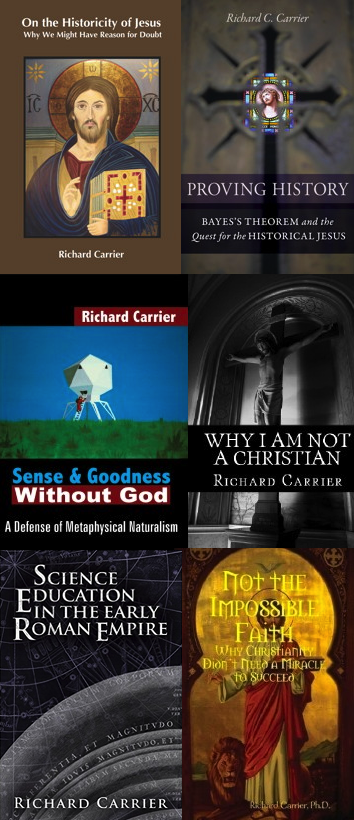 Here continues my series on reviews of my book On the Historicity of Jesus. If you know of reviews I haven’t covered, post them in comments (though please also remark on your own estimation of their merits).
Here continues my series on reviews of my book On the Historicity of Jesus. If you know of reviews I haven’t covered, post them in comments (though please also remark on your own estimation of their merits).
-:-
This series has covered another series begun by Nicholas Covington. I have already commented on earlier entries (see part 3). Today I shall comment on parts 4 and 5.
In these entries, Covington actually proposes that I under-sell my argument, and that in fact it’s even stronger than I think. He may be right.
Did Demons Kill Jesus?
In part 4, Covington does a good job of explaining why we should concur with several background ideas that my theory rests upon (a more basic, stripped-down Doherty thesis), in this case the theory that Paul probably is referring to demons as the killers of Jesus in 1 Corinthians 2, and that it actually was readily understood in antiquity that things could be planted, built, and buried in outer space (as to them the layered heavens were just other levels of the world, each with their own contents, paralleling everything found on earth).
I need only add a few remarks. When Covington says he’s “no expert in ancient Greek” so “for all [he] know[s] it could be routine for historians to analyze the meanings of Greek words within extremely narrow time-frames [of just fifty years], nonetheless it strikes me as contrived” to do that. Covington is right. It would be extremely bizarre for Classicists to change the definitions of words in half-century time-units. In fact ancient languages were fairly stable, and definitions typically took centuries to shift significantly. Attempting to claim words completely changed their meaning in the course of just one average lifetime is an unusual claim. It requires unusual evidence. It therefore cannot simply be asserted.
Moreover, in respect to 1 Cor. 2:6-8, Gordon Fee’s claim that “‘rulers of this age’ is not used to refer to demons until the second century” is either moot (we have so few documents from the period between Paul and the 2nd century that no claims can be made like this based simply on what extant documents contain) or implausible (I extensively document the evidence of, and scholarship on, multiple different words and phrases for the demonic powers and their use and meaning in OHJ, Element 37). As Covington notes, Paul calls Satan the “god of this age” (2 Cor. 4:4), but I should add the Gospels (even Mark) call Satan the archon, ‘ruler’ (Mk. 3:22). It’s easy to see what people would understand by ‘rulers of this age’…a phrase, incidentally, never used of humans. So Fee’s own methodology, “if we don’t see it, it didn’t happen,” would nix his own argument from the start. Fee is engaging in apologetics, not scholarship.
Certainly, the ambiguity still exists, since the phrase could refer to humans, although I do adduce two strong reasons why in this case that’s unlikely in OHJ, pp. 564-66 and 572-73. But what if we assume it’s still ambiguous and could as easily mean either? Covington concludes with a remarkable point that I actually didn’t consider in my book: since on mythicism the only way Paul could refer to the execution of Jesus is with a phrase that can mean demonic powers, the probability of our seeing such a phrase here is 100%; whereas on historicity, we have no particular reason to expect Paul to have used such a phrase, he could as easily have used one that excludes demonic powers and explicitly identifies earthly powers, and when we have no particular reason to expect either more than the other, the probability of the evidence we then have is 50%. This alone creates a 2:1 factor in favor of mythicism. I did not include that in my math. And it’s not clear how a historicist can escape the logic of doing so.
I had mistakenly assumed that since this phrase can mean either, it is equally expected on both theories (and therefore argues for neither). But I think Covington may be right. If anyone can argue me out of that conclusion, please try. Because it becomes rather damning of historicity if accepted. In OHJ (pp. 563-74; 594) I treat the entire array of “things Jesus did” (including get crucified) as 2:1 in favor of mythicism (3:4 a fortiori). But if this one phrase alone carries that much weight, then my estimates are significantly more generous to historicity than they logically should be.
Covington became less certain after further discussion (see the first section of his part 9 and the comments section of his part 4, although much of that comes from Bernard Muller, who is known to deal in disinformation, false claims, and irrational inferences). But I don’t think the objections raised alter the calculation, because the ambiguity is still not expected on historicity, whereas especially in conjunction with b (our knowledge of the filter), it is expected on myth.
Should the Shift in Who Is Proclaiming the Gospel Count More?
In part 5, Covington proposes:
I’m going to take Carrier to task for missing an important piece of evidence … a piece of evidence that supports his theory. … In the Pauline letters, Jesus is the proclaimed, whereas in the gospels Jesus is the proclaimer. In other words, the gospels portray Jesus as one proclaiming the kingdom of God, whereas in the Pauline letters, the order is reversed: Jesus is what the kingdom of God proclaims.
I actually do mention this in OHJ (e.g., pp. 554-55; cf. pp. 594, 530, 528, 520-21, 516-17, and also in respect to Clement of Rome, p. 314), but Covington does a better job of calling attention to it (and he even cites more scholarship in support). But I zero-out it’s significance, concluding this is equally likely on either theory (minimal historicity or mythicism). Covington disagrees and thinks it should favor mythicism by a factor of 9 to 5.
I’m sympathetic to this. It is certainly a reasonable proposal when arguing a judicantiori (rather than a fortiori), i.e. when modeling what you personally think must be the case even if you are certain stalwart deniers could never be persuaded of it. And I do mention in OHJ from time to time that even my a judicantiori estimates are often over-generous (e.g., pp. 308 and pp. 557, n. 55, and 574-75, n. 82). This may be another instance.
But I was not fully persuaded when I wrote OHJ.
First, although indeed the switch from “Jesus proclaimed” to “Jesus proclaimer” is weird and makes little sense if the Gospel accounts are histories, the Gospel accounts are not histories. And there’s the rub. When we are testing minimal historicity, we are not presuming that what the Gospels say is what happened. To the contrary we are fully allowing that it is not. Consequently, it is entirely possible that Jesus did not do any proclaiming (beyond just prophesy, say), and that it was his followers who started that up after his death. The Gospels then fabricate his “ministry of proclaiming” in order to more effectively allegorize what his followers actually had until then been proclaiming about him. On minimal historicity this is as expected as anything else (because minimal historicity does not predict the contrary).
Although Covington can still capitalize on this. Because this commits the historicist to such a stripped-down historicity as to put the kaibosh on almost every cherished theory of the historical Jesus. But if they want to rescue the baby of historicity, they may be willing to throw out the bathwater of comforting theories about what Jesus actually did. Although that does create even graver problems for them, as I note in OHJ, pp. 557, n. 55, and 574-75, n. 82. So it’s worth pushing them into that corner, even if only to compel them to realize what it entails.
But second, it’s also just as likely Jesus did proclaim, but was just so unknown and unlistened to, that his followers had to switch to proclaiming him (becoming his ad men—in effect, for what was in life a failed product pitch). The Gospels could then have restored the original order, even if with fabricated accounts of it, because they are a different kind of teaching tool than the Epistles. Thus, all historicist attempts to “explain away” the silence of Paul’s letters (with respect to Jesus having a ministry) apply here as well: maybe Paul never did have an occasion to clearly say that’s where any Christian teachings came from. Personally, I do think that’s unlikely. But a fortiori?
So I think Covington is at least right that my a judicantiori estimate for Jesus’ sayings is over-generous to historicity and should not be 1:1, on the same reasoning as previous: the Epistles display the only way Paul could talk about the gospel on mythicism (or almost, see below), but that is not the only way he could have spoken on historicity. One might counter that he could also have spoken more explicitly of the cosmic origin of the gospel (so what we have is not the only way he could have written about it), but b (our background evidence) counters that in turn, because we know the Epistles passed through a very corrosive filter (OHJ, Element 21) that would have destroyed any such thing (to a very high probability, e.g., if Paul wrote any letter saying something explicitly anti-historicist, it simply would not have been preserved for us to know if it: OHJ, pp. 552, 593-94, and ch. 8, §12). Whereas that filter would have had the opposite effect on historicity: had Paul written anything more explicitly historicist, that probably would have been preserved.
So Covington may be right: for the Epistles to speak of proclaiming Jesus rather than Jesus proclaiming anything could be 2:1 more likely on mythicism.
At first look I should have thus replaced my 1:1 (for ‘things Jesus said’) with that 2:1 (OHJ, p. 594) in the ‘worst’ case column. For the ‘best’ case column, it should be 3:4, on the reasoning that the text as we have it is all but 100% expected on mythicism, but on minimal historicity there is a 50% chance Jesus never did proclaim a gospel, and if he did, there is a 50% chance it was so unknown and unlistened to that it had to be proclaimed by others first, before his fame would be enough to write stories about what he proclaimed (in each case it’s 50% because, I am assuming, we don’t know one way or the other which is more likely—since mininmal mythicism says nothing about that, and there is nothing in b that makes either more likely than the other…if we think a fortiori, although see again p. 557, n. 55). That means even a fortiori the evidence of the Epistles is only 75% likely on minimal historicity, on the most generous framing of options possible (50% + [50% x 50%] = 50% + 25% = 75%). That gives us 75:100, which is 3:4.
But there is one hitch: on mythicism it is actually possible to have preached Jesus as a proclaimer from the start—by saying the heavenly Jesus proclaimed a message (to the apostles, and through their proxy, to the world) which is now being delivered. There may well be texts already that say this. So the sequence ‘proclaimed-proclaimer’ (our e) may be more likely on mythicism, but the sequence ‘proclaimed-proclaimed’ was also genuinely possible on mythicism, so P(~e|m) is not zero, which entails P(e|m) cannot be 100% (Proving History, pp. 230-31, 255-56, and 302, n. 13). When we carry out the math from there I think this may entail a wash a fortiori (1:1), and at best 3:4 against historicity a judicantiori (to reflect the fact that it’s more expected to see our e if historicity is false, given that those rescuing assumptions for historicity are not really 50/50, because in fact our world knowledge in b renders them unusual and thus unlikely).
Although that still means, so far, it looks like Covington’s review of OHJ is making its conclusion stronger.
-:-
More to come. See my commentary on part 3, if you want to walk back in the series. I will eventually blog on all of Covington’s entries in this series (his continuing index is here).
-:-
For a complete list of my responses to critiques of OHJ, see the last section of my List of Responses to Defenders of the Historicity of Jesus.







Hi Richard. Have you had any notice that your book will be reviewed in any major publications? I would hate to see such a masterwork published then fail to reach a wide audience, while having to watch claptrap like Reza Aslan’s continue to be reviewed everywhere.
It’s too soon to know. Academic reviews of university monographs can take one or two years to appear in print.
Are you going to be responding to David Marshall’s review?
You mean his Amazon review?
Maybe. He is so full of shit it’s hard to stomach even the bother. The book already refutes him, and as a rule, when a critic is already refuted by the book they are critiquing, there is rarely any need to respond further.
But it depends on whether I find any spare time to sport with him.
I don’t see how this is generically 50%. It seems to me that the number would be the probability that, under historicity, Paul would use a phrase that could include demonic powers. In principle, you could calculate this by listing all phrases Paul could have used under historicity, together with their probabilities under historicity (e.g. Paul is more likely to use common Greek phrase A than contorted Greek phrase B). These probabilities would sum to 1. You would then add up the probabilities just for those phrases that could also mean demons (yielding a number greater than 0 but less than 1).
Maybe all of the most plausible phrases have this ambiguity in meaning (I have no idea)–in that case, the point is interesting but has little effect on the math. Maybe only one of the plausible phrases could refer to demons, in which case this one point is conclusive. In other words, I agree that the evidence here is in favor of mythicism, but I have no idea of its value, and see no particular reason why it should be 0.5.
And when we know of nothing that makes that more likely or less, then so far as we know it’s 50/50. Hence 50/50 is the default probability for having no reason to expect either outcome more than the other.
Your proposed method makes no sense. The probability in question is not the ratio of the number of ways to form a sentence. It’s the probability that he would be coincidentally vague in ratio to the probability that he would be non-coincidentally specific. The number of ways Greek allowed him to do either is irrelevant. So is the number of ways he does so elsewhere in his letters, unless you can non-circularly know when his vagueness belies the same meaning as the specific, but you can’t. For example, if Paul had elsewhere said the “rulers of this age” were the Jewish and Roman authorities, then to a high probability when used in other passages the vague phrase means that specific phrase. But that is precisely the data we don’t have (on either side of the question). So it’s a draw.
Since you asked, I had a notion that might persuade you away from Paul talking only about demons.
“Archon” seems to shift meaning within certain contexts. Given that “rulers of this age” has always been used to apply to supernatural beings, there’s also the possibility that Paul could have used this phrase to imply simultaneous material and spiritual struggle.
I won’t pretend to understand the details enough to assign a probability, but the two factors that would influence this is the likelihood that Paul overall believed in simultaneous temporal/spiritual struggle around Jesus, and the likelihood that he would use this phrase and context to imply this.
Given that Paul has also discussed secret teachings, such obtuse phrasing might be intended to clue in readers that there is a deeper meaning going on… while the common understanding is that the rulers of this age are supernatural, the secret concurrent meaning is of temporal rulers. The politics of the time would suggest that there is motivation for obliquely referring to actual rulers for reasons of safety, potentially make the probability of a dual meaning higher.
That doesn’t get us anywhere mathematically. Simultaneous theatres is already a sub-thesis of the earthly meaning thesis. So adding it changes nothing. We still are at 50/50, not knowing whether he means earthly (alone or as well) or celestial alone. Unless, of course, we credit the many reasons in OHJ I provide for concluding against the former. There are no comparable arguments the other way around.
P.S. Regarding The politics of the time would suggest that there is motivation for obliquely referring to actual rulers for reasons of safety: That isn’t true. That’s a Christian myth (and not just a la Candida Moss et al.). There is absolutely no reason their safety would be in any way compromised by saying Jesus was crucified by the Romans. It’s not as if the fact that they were worshiping a crucified man was a secret. It was in fact the most public thing about the cult. Though that might have been compromising, that cat was already well out of the bag. So it would make no sense for Christians, routinely proclaiming this in public, to get all hush hush about it in their own private internal correspondence.
“I actually do mention this in OHJ (e.g., pp. 554-55; cf. pp. 594, 530, 528, 520-21, 516-17, and also in respect to Clement of Rome, p. 314), but Covington does a better job of calling attention to it (and he even cites more scholarship in support). But I zero-out it’s significance, concluding this is equally likely on either theory (minimal historicity or mythicism).”
I think there’s an angle on this that you’ve missed. Here’s an analogy: 2 Peter supports mythicism by saying that Christian beliefs are not ‘cleverly devised fables’ and attesting that Paul’s words needed careful interpretation — thus indicating that someone thought that Christian beliefs were cleverly devised fables and that some early Christians had a radically different understanding of Paul’s letters than the author of 2 Peter did, which corroborates the mythicist hypothesis for reasons you spell out in OHJ.
In like manner, the fact that Luke was attempting (once again) to resolve an incongruity indicates that somebody saw that incongruity; it shows that somebody had noticed that the picture of Jesus was fundamentally different in the gospels and the epistles, indicating that the incongruity is real and not just a figment of the mythicist’s imagination or theorizing.
And there’s another angle on this issue that supports mythicism even more. Why did Luke feel the need to harmonize the two portraits? Maybe he was just eager to harmonize a biblical contradiction. On the other hand, if there two competing schools of thought within the second century church, one that saw Jesus as a purely heavenly figure (as Paul seems to have seen him) and another that came to see Jesus as a regular guy (or new initiates who were taught this at first) then that makes probable that Luke would have to confront the incongruent portraits and bring them together somehow.
I don’t think we can believe that Luke was like an ancient Norman Geisler, desperately trying to harmonize even the most nit-picking inconsistencies. Again: what was Luke doing? In 1 Corinthians 3:5-24, you pointed out that Paul had to explain that Apollos did not really contradict his teachings, but rather, Apollos was merely building on what had he had taught previously. If new initiates into the cult were liable to be confused (or were already confused and raising questions about the proclaimed / proclaimer issue) Luke would have had a pressing need to explain the contradiction so as to keep the newest initiates in the dark until it was time for them to receive a higher level of understanding (either that, or Luke foresaw that such a problem could easily arise and wanted to head it off before it erupted).
That’s just restating the same thesis, and adding another on top of it. It meets with the same objections.
It meets with another, as well, of course, which is that with such a thesis we are importing motives to Luke that are not certain. I presume Luke himself does not show any anxiety over there being both forms of proclamation. So why are we assuming that Luke is “noticing” something that worried him and that had to be “corrected”? Maybe he’s just repeating the way things were, and had always been (and the idiosyncrasy is just in Paul…and Clement…etc.).
I don’t mean that therefore we should so conclude. I mean there are so many possibilities, and we have no actual evidence to render any more likely than the other, that therefore we are stuck with the same conundrum of not quite knowing the causes of this evidence, and having multiple hypotheses that we must give probability space to. Just as I explain.
Now, whether my resulting numbers can be changed based on any such reasoning as you suggest, that’s possible. But someone would really need to develop that case in detail. I do think you have an interesting possibility to explore, and someone might one day do a literary analysis of Luke to see if they can show it more likely than not that Luke is indeed attempting to harmonize two sectarian views of the origin of the Gospel. But until that’s done, it remains just an interesting possibility. I am skeptical (because I don’t right off hand see any evidence in Luke that is determinative here). But someone could easily do such a study and surprise me. I’d welcome it, of course.
But here is an example of what I mean…
Where, though, does Luke explain the contradiction? He just seems to use both modes willy nilly, not even conscious that there is a contradiction. That does not mean he wasn’t. But it does mean there’s a lot of hard work to do to show he was.
Perhaps in a couple of years you can do a recalculation based on any incoming evidence / criticisms between now and then. That would make for an interesting read if you can find the time. Like you, I think Covington makes a good point regarding Paul’s choice of phrase in 1 Corinthians 2. If you decided to be nerdy about it, how do you think factoring this in would affect your calculations?
Not a review of this book, but there is an article on AlterNet by Valerie Tarico titled “5 Reasons to Suspect Jesus Never Existed” that mentions you, your role in the Jesus Myth idea, and links to the books page on your personal website. Look forward to checking out “On the Historicity of Jesus.”
Richard, what do you get from this? Below is from a secular website that I believe promotes your work too.
“1. The prophecy
Matthew says that Judas’ payment and death were prophesied by Jeremiah, and then he quotesZechariah 11:12-13 as proof!
2. Thirty pieces of silver
According to Matthew 26:15, the chief priests “weighed out thirty pieces of silver” to give to Judas. There are two things wrong with this:
a. There were no “pieces of silver” used as currency in Jesus’ time – they had gone out of circulation about 300 years before.
b. In Jesus’ time, minted coins were used – currency was not “weighed out.”
By using phrases that made sense in Zechariah’s time but not in Jesus’ time Matthew once again gives away the fact that he creates events in his gospel to match “prophecies” he finds in the Old Testament.”
Hi Richard. I found this on some secular site that actually promotes you with a dvd advertisement. I was wondering if this is correct about the silver?
(JUDAS ISCARIOT
It is very unclear in the gospels just what Judas Iscariot’s betrayal consisted of, probably because there was absolutely no need for a betrayal. Jesus could have been arrested any number of times without the general populace knowing about it. It would have been simple to keep tabs on his whereabouts. The religious authorities did not need a betrayal – only the gospel writers needed a betrayal, so that a few more “prophecies” could be fulfilled. The whole episode is pure fiction – and, as might be expected, it is riddled with contradictions.
1. The prophecy
Matthew says that Judas’ payment and death were prophesied by Jeremiah, and then he quotesZechariah 11:12-13 as proof!
2. Thirty pieces of silver
According to Matthew 26:15, the chief priests “weighed out thirty pieces of silver” to give to Judas. There are two things wrong with this:
a. There were no “pieces of silver” used as currency in Jesus’ time – they had gone out of circulation about 300 years before.
b. In Jesus’ time, minted coins were used – currency was not “weighed out.”
By using phrases that made sense in Zechariah’s time but not in Jesus’ time Matthew once again gives away the fact that he creates events in his gospel to match “prophecies” he finds in the Old Testament.)
Hi Richard. I found this on some secular site that actually promotes you with a dvd advertisement. I was wondering if this is correct about the silver?
(JUDAS ISCARIOT
It is very unclear in the gospels just what Judas Iscariot’s betrayal consisted of, probably because there was absolutely no need for a betrayal. Jesus could have been arrested any number of times without the general populace knowing about it. It would have been simple to keep tabs on his whereabouts. The religious authorities did not need a betrayal – only the gospel writers needed a betrayal, so that a few more “prophecies” could be fulfilled. The whole episode is pure fiction – and, as might be expected, it is riddled with contradictions.
1. The prophecy
Matthew says that Judas’ payment and death were prophesied by Jeremiah, and then he quotesZechariah 11:12-13 as proof!
2. Thirty pieces of silver
According to Matthew 26:15, the chief priests “weighed out thirty pieces of silver” to give to Judas. There are two things wrong with this:
a. There were no “pieces of silver” used as currency in Jesus’ time – they had gone out of circulation about 300 years before.
b. In Jesus’ time, minted coins were used – currency was not “weighed out.”
By using phrases that made sense in Zechariah’s time but not in Jesus’ time Matthew once again gives away the fact that he creates events in his gospel to match “prophecies” he finds in the Old Testament.)
If it came up more than once, sorry. My phone froze.
Having troubles posting here. Richard, with your expertise can you please validate this. Is it true about the “silver”. Coins or bars I just want to know if there was pieces or were they out of circulation & did they use silver in 1st century because I thought they did since we still use it today?
“JUDAS ISCARIOT
It is very unclear in the gospels just what Judas Iscariot’s betrayal consisted of, probably because there was absolutely no need for a betrayal. Jesus could have been arrested any number of times without the general populace knowing about it. It would have been simple to keep tabs on his whereabouts. The religious authorities did not need a betrayal – only the gospel writers needed a betrayal, so that a few more “prophecies” could be fulfilled. The whole episode is pure fiction – and, as might be expected, it is riddled with contradictions.
1. The prophecy
Matthew says that Judas’ payment and death were prophesied by Jeremiah, and then he quotesZechariah 11:12-13 as proof!
2. Thirty pieces of silver
According to Matthew 26:15, the chief priests “weighed out thirty pieces of silver” to give to Judas. There are two things wrong with this:
a. There were no “pieces of silver” used as currency in Jesus’ time – they had gone out of circulation about 300 years before.
b. In Jesus’ time, minted coins were used – currency was not “weighed out.”
By using phrases that made sense in Zechariah’s time but not in Jesus’ time Matthew once again gives away the fact that he creates events in his gospel to match “prophecies” he finds in the Old Testament.”